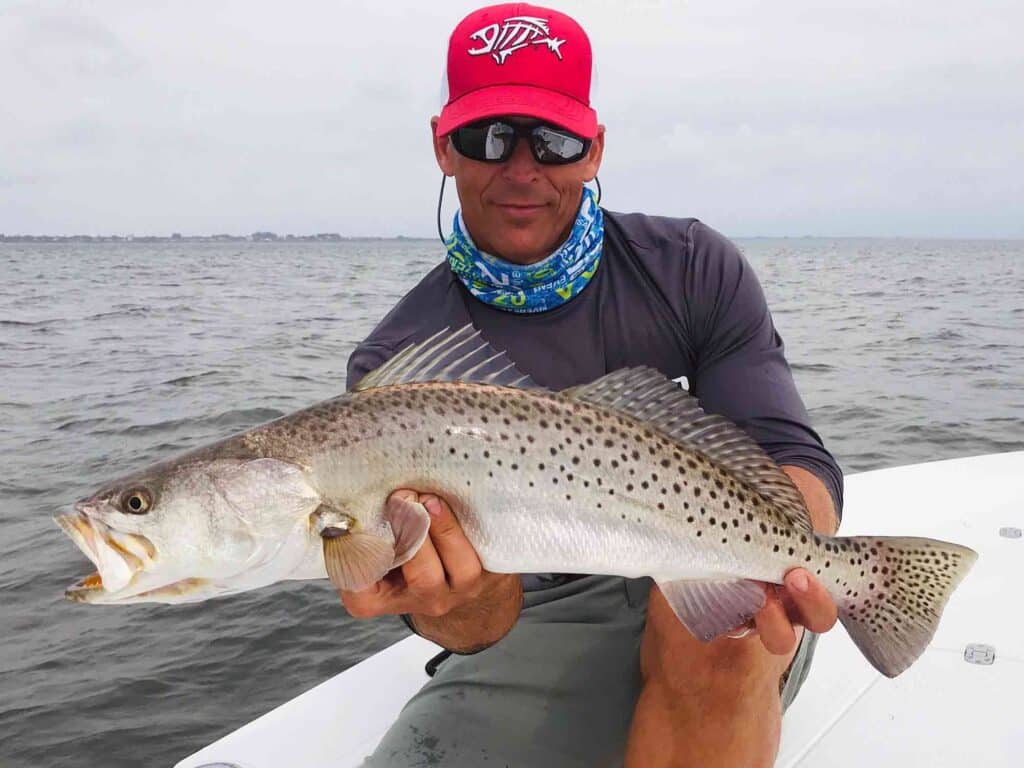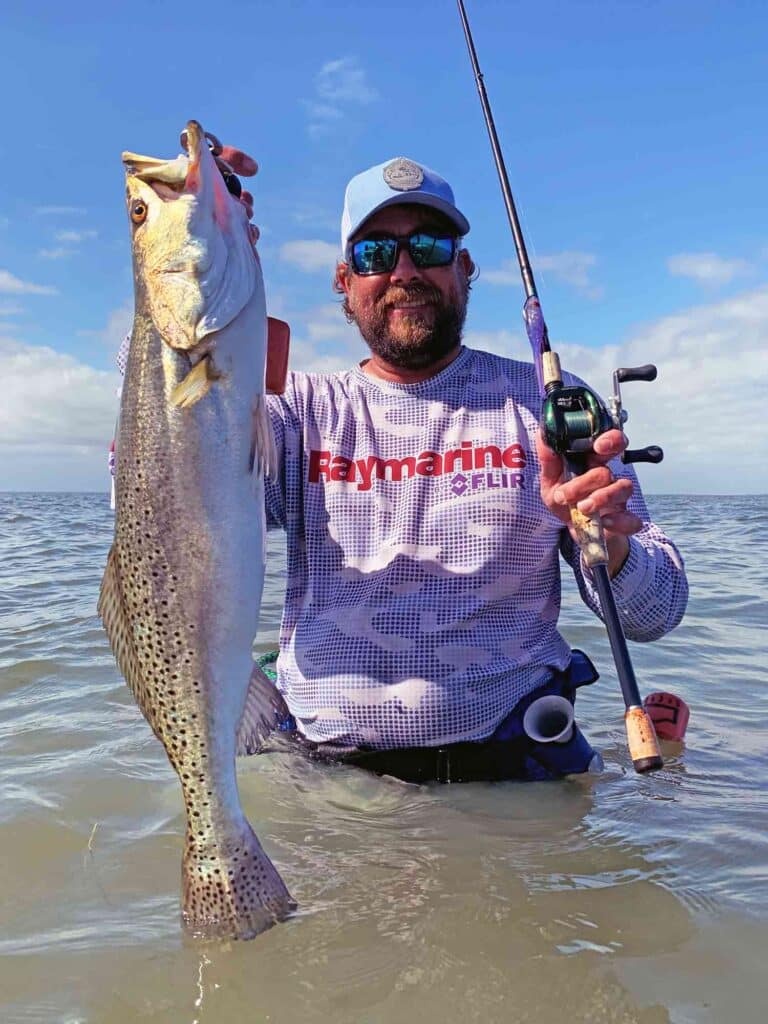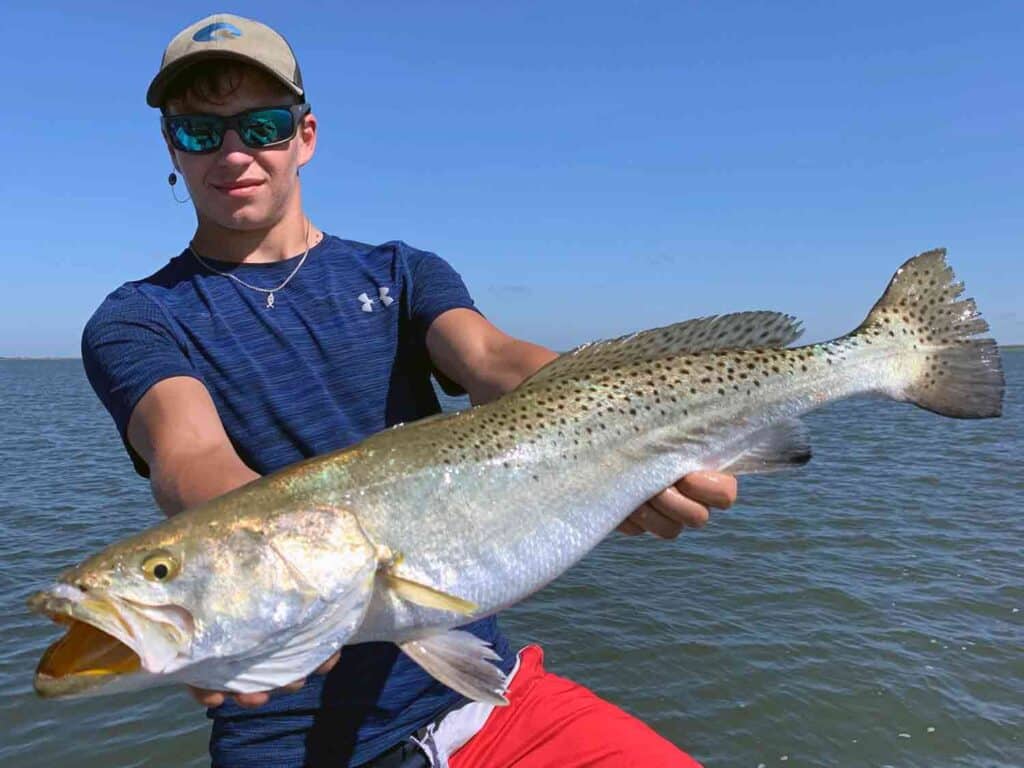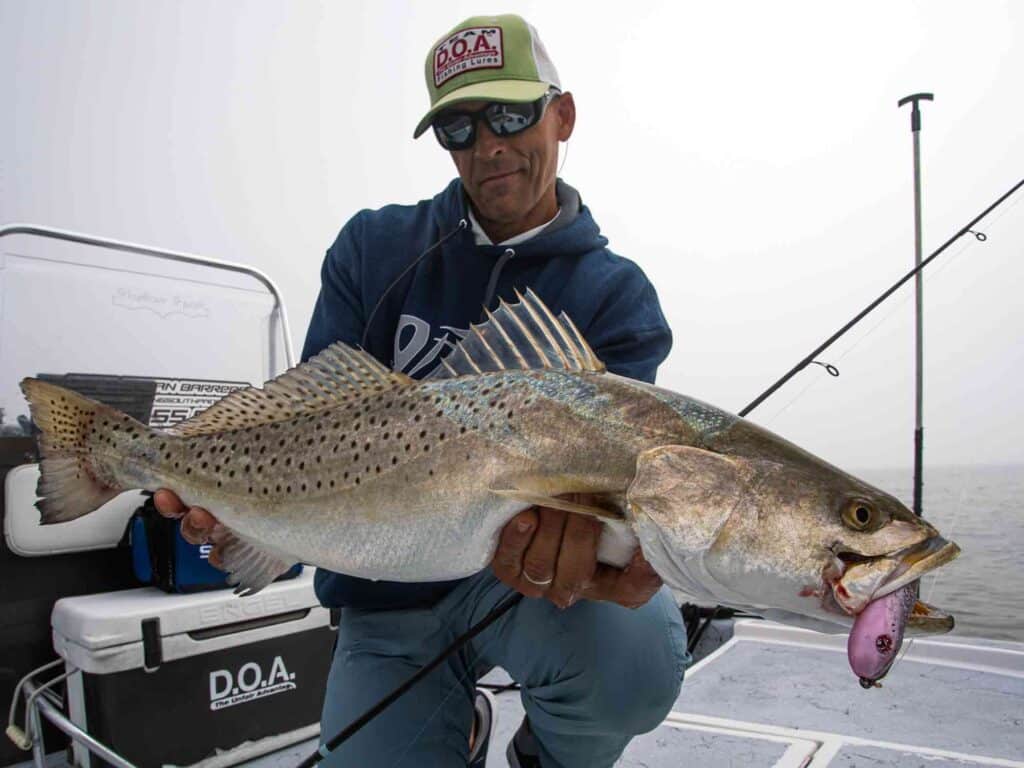
Spotted seatrout. Speckled trout. Specks. No matter the name, this inshore species is one of the most popular game fish on the Gulf and Atlantic coasts. The IGFA all-tackle world record, caught on May 11, 1995, by Craig Carson at Fort Pierce, Florida, weighed a massive 17 pounds, 7 ounces. Behemoths like that are rare, but many light-tackle anglers dream of catching a true trophy pushing double-digits sometime during their lifetime. So we asked three experts to tell us what they do and look for when targeting that specific bucket list prize.
Catching Gator Florida Seatrout

“Growing up fishing the Indian River Lagoon, I got pretty spoiled. It wasn’t unusual to catch a dozen fish over 10 pounds every season,” says Capt. Ed Zyak. “This is where the world record was caught. There are still big fish left, just not in the numbers as before. It really depends on where you are, though. On Florida’s southwest coast, a 7-pounder is a really good fish. But I still get really excited breaking that 10-pound mark.”
Zyak looks for out of the way places near Ft. Pierce that don’t get a lot of traffic, preferably on a new moon. Small shallow spots adjacent to deeper water, like the backside of a bar, are the focus of his attention. He prefers to get out of the boat to wade on the last of the falling and first of the incoming tides, which concentrates the bait. Zyak watches for telltale signs like minnows stacked up, the presence of big mullet, birds feeding and water funneling through the zone.
“Figuring out water flow is important,” Zyak says. “I’ll often kick up a little sand to gauge the current. You have to adjust the presentation according to the conditions, but typically I’ll cast a jerk bait or shrimp up-tide and let it sweep parallel to the bait, using a twitch-and-short-pause retrieve. The strikes usually come on the pause. I’ll stand still and pick a spot apart for an hour. The seatrout settle down and forget you’re even there, especially with long casts. That requires confidence and patience. You’re not trying to catch 30 fish, you’re looking for one or two chances at a trophy and that means a slow, methodical approach.”
Florida Seatrout Fishing Gear
Here’s what Capt. Ed Zyak, of Florida’s Indian River Lagoon, recommends:
- Favorite Months: April & May
- Rods: 7.5’ Medium spin rod with extra fast action
- Reels: 4000 class spin
- Line: 10-pound braided line, 30- to 40-pound test fluorocarbon leader
- Lures: 3-inch shad or paddles tails; 1/4-ounce artificial shrimp; Shimano Coltsniper topwater plugs
- Bait: Live pilchards
- Tip: “Patience and silence are the keys. Slow down, pay attention to the conditions and pick a spot apart.”
Giant Gulf Coast Spotted Seatrout

“I didn’t actually weigh any of my three biggest fish,” explains Capt. Richard Rutland. “I measured and released them as quickly as possible. If it takes two hands to pick one up, that’s a big seatrout for the central Gulf. They’re usually pushing 30 inches and up to nine pounds.”
Rutland often finds big cooperative fish in early December. He targets the tidal rivers off Mobile Bay where the deeper channels offer sanctuary from the cold. As the sun warms the adjacent flats, the trout will come up to warm and feed in the shallows. In deeper water he cranks the reel slowly and steadily with an occasional twitch to add action to the lure.
April and May are the big spawning months and Rutland prefers to fish right before or after the full moon when large females are active. His three warm-water zones are grass flats, oyster bars/shells and sand bars along the beach.
“I’m always wading whenever I can,” he says. “It’s much quieter and stealthy, so you have a better chance. I’m also more aggressive with my presentation when it’s warm. I’ll whack, whack the lure, let it flutter and then repeat at a faster pace to trigger reactionary strikes.”

Rutland says the weaker tides aren’t as much a factor in his region, as long as the fish have enough water to feel comfortable. If he’s in the boat with clients, he aligns with the wind and current to drift and reach prime zones with long casts.
Rutland’s go-to lure is a soft-plastic jerk bait made by PureFlats. The Slick has a long tail rigged with an Owner swimbait hook plain or slightly weighed. Natural colors top the list, but he will switch to brighter patterns for contrast in cloudy water. For live bait, it’s croakers, finger mullet or small menhaden free-lined on a 2/0 kahle hook.
“You have to be very, very patient to target big fish,” he adds. “You might only get four or five bites all day long. Catching one is a waiting game.”
Gulf Coast Seatrout Fishing Gear
Capt. Richard Rutland, of Dauphin Island and Mobile Bay, Alabama, recommends:
- Favorite Months: Second week of December, April & May
- Rods: 7.5’ baitcaster with soft tip and action
- Reels: 3000 class baitcasting reel
- Line: 30-pound braided line with 15- to 20-pound fluorocarbon leader
- Lures: Pure Flats The Slick jerk bait with Owner 4/0 Beast worm hook
- Bait: Live croaker, finger mullet
- Tip: “It’s always about distance and not alerting the fish. I try to cast as far as I can to cover more water and discern feeding patterns.”
Trophy Texas Seatrout Fishing

“Laguna Madre and Baffin Bay are hyper-saline systems that grow huge fish,” says Capt. Joe Farah. “But those fish are also very aware of their surroundings, so any boat noise or pressure wave puts them on alert. So whether you’re wading or drifting you have to stalk quietly and not give away your presence.”
Farah keys in on specific types of habitat when targeting large trout. He concentrates on small areas, usually 300 yards in size or less, quick access to deep water for escape, mud and sand, seagrasses and shell.
“I always watch for baitfish and birds. Terns, laughing gulls and heron will be after finger mullet. Pelicans will focus on shad, while sand pipers are looking for clams and eels. Find all those and you’ve got a big trout buffet.”
Farah prefers to cast into the wind, since resting trout will be facing the wind and current. That approach keeps him in the fish’s blind spot and brings the lure into their vision, where they can assess and kill the prey.
In February and March he typically throws a 5.5 jerk bait with 1/16-oz. jig head in tequila sunrise, dark black and red for fish warming in the shallow grass. In November, as the water starts to cool, there’s a late spawn and he switches to a rainbow trout-colored swim bait with 1/8-oz. jig to mimic the shad. He adds large topwater plugs to the mix in the spring and fall.

“You have to make every cast count. That’s why I use plugs in bright colors to track and detect any swipes or blow-ups. But I work them extremely slow, with short pauses to let them sit and roll in the waves to mimic an injured, dying bait. It often takes three minutes to retrieve a lure. The idea is putting a victim in the hunting zone. A trophy trout is extremely smart and wary. If something doesn’t look right, Old Google Eyes is going to say, ‘Nope, not this one.’”
Texas Seatrout Fishing Gear
Capt. Joe Farah, of Baffin Bay and Laguna Madre, Texas, recommends:
- Favorite Months: February, April, May, November
- Rods: 7’ medium fast spin
- Reels: 3000 class spin
- Line: 15-pound braid with 30-pound-test monofilament leaders for stretch
- Lures: MirrOlures or Heddons in bright colors for visibility; 4-inch swim bait in rainbow trout, jerk shads in natural colors with 1/16- to 3/8-oz. short shank jigheads
- Bait: Live shrimp under popping cork in the spring, summer months live croaker and piggy perch
- Tip: “Trophy trout fishing is like hunting. You don’t catch big ones catching numbers. You have to concentrate on spots that only hold big fish.”








